
Two leading experts in the field of carbon capture and sequestration (CCS)– Howard J. Herzog , a senior research designer in the MIT Power Initiative, and Niall Mac Dowell, a teacher in energy systems engineering at Imperial University London– discover techniques for getting rid of co2 already in the environment in their new publication, Carbon Elimination Released in October, the book becomes part of the Essential Understanding series from the MIT Press, which includes quantities “synthesizing specialized subject for nonspecialists” and includes Herzog’s 2018 book Carbon Capture
Burning fossil fuels in addition to various other human tasks create the release of co2 (CARBON MONOXIDE 2 right into the ambience, where it acts like a blanket that heats the Earth causing climate adjustment. Much focus has actually focused on mitigation modern technologies that lower discharges, but in their publication, Herzog and Mac Dowell have transformed their focus to “co2 elimination” (CDR), an approach that eliminates carbon already present in the atmosphere.
In this new volume, the writers explain exactly how carbon monoxide 2 normally moves into and out of the environment and present a quick history of carbon removal as a concept for handling environment change. They also describe the complete variety of “paths” that have been suggested for eliminating CO 2 from the atmosphere. Those pathways consist of engineered systems designed for “direct air capture” (DAC) as well as various “nature-based” techniques that ask for growing trees or taking actions to boost removal by biomass or the oceans. The book supplies easily accessible descriptions of the basic science and engineering behind each technique.
The authors compare the “quality” of the various pathways based upon the complying with metrics:
Bookkeeping. For public approval of any kind of carbon-removal strategy, the writers keep in mind, the developers need to get the accounting right– and that’s not always easy. “If you’re mosting likely to invest cash to obtain carbon monoxide 2 out of the ambience, you intend to earn money for doing it,” keeps in mind Herzog. It can be difficult to gauge just how much you have removed because there’s a lot of carbon monoxide 2 going in and out of the environment all the time. Additionally, if your technique involves, claim, melting fossil fuels, you should deduct the quantity of CO 2 that’s discharged from the complete quantity you assert to have removed. After that there’s the timing of the elimination. With a DAC tool, the removal happens today, and the removed CO 2 can be determined. “However if I grow a tree, it’s going to remove CO 2 for years. Is that comparable to eliminating it today?” Herzog inquiries. How to take that element right into account hasn’t yet been solved.
Permanence. Various techniques keep the carbon monoxide 2 out of the environment for different periods of time. How long is long sufficient? As the authors explain, this is among the largest concerns, especially with nature-based remedies, where events such as wildfires or plague or land-use changes can release the saved carbon monoxide 2 back into the atmosphere. Just how do we deal with that?
Expense. Cost is another crucial aspect. Using a DAC gadget to remove CO 2 costs even more than growing trees, however it produces prompt elimination of a measurable amount of CO 2 that can after that be secured away for life. Exactly how does one monetize that compromise?
Additionality. “You’re doing this project, however would what you’re doing have been done anyway?” asks Herzog. “Is your initiative added to service as usual?” This concern comes into play with a number of the nature-based approaches including trees, soils, and so forth.
Allowing and administration. These problems are particularly crucial– and made complex– with methods that entail doing points in the sea. Additionally, Herzog explains that some CCS projects can also attain carbon elimination, however they would have a tough time getting licenses to construct the pipes and various other required framework.
The authors end that none of the CDR approaches currently being suggested is a clear champion on all the metrics. Nonetheless, they worry that carbon elimination has the possible to play an important role in satisfying our environment change objectives– not by changing our emissions-reduction efforts however rather by supplementing them. Nevertheless, as Herzog and Mac Dowell make clear in their book, numerous difficulties should be resolved to move CDR from today’s conjecture to implementation at scale, and guide supports the broader conversation regarding exactly how to move on. Without a doubt, the writers have actually met their mentioned goal: “to give an objective evaluation of the chances and difficulties for CDR and to separate misconception from reality.”